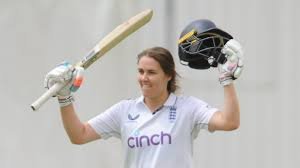Nat Sciver-Brunt Sets Record for Fastest Test Century
Introduction: Breaking a Major Cricket Record
In an exciting moment for women’s cricket, Nat Sciver-Brunt of England set a remarkable record for the fastest century in Test cricket. This incredible feat occurred during the second day of England’s Women’s Test match against Australia. The record-breaking century was achieved in just 107 balls, shattering the previous record of 114 balls. Sciver-Brunt’s aggressive approach and exceptional skills have been lauded as a defining moment in women’s cricket, showcasing the growing competitiveness of the women’s game.
Details of the Record-Breaking Century
Sciver-Brunt’s century came at a time when the England team was looking for a strong performance, and her rapid scoring helped the team regain momentum in the match. Her ability to dominate the Australian bowlers in such a fashion not only set a personal achievement but also highlighted the expanding boundaries of women’s cricket globally. Her approach to batting in the Test match was a blend of classic technique and modern aggression, a combination that proved lethal on the field.
Impact of the Record on Women’s Cricket
This record sets a new benchmark for women’s Test cricket. It demonstrates the increasing power and talent of female cricketers, further bridging the gap between women’s and men’s cricket. Sciver-Brunt’s achievement will inspire future generations of female athletes to aim for greater heights, bringing more recognition to women’s cricket on the global stage.

Why This News is Important
Highlighting the Growth of Women’s Cricket
Nat Sciver-Brunt’s achievement is a landmark moment for women’s cricket, bringing the sport to the forefront of global sporting discussions. The growing recognition of women’s cricket and the increasing media attention on female athletes reflect a broader cultural shift toward equality in sports. This historic achievement not only celebrates Sciver-Brunt’s talent but also represents the collective progress of women’s cricket in terms of both skill and visibility. The record is a significant milestone that proves the immense potential within the women’s cricketing world, inspiring young girls and athletes across the globe to pursue their passion for the sport.
Inspiration for Future Cricketers
Sciver-Brunt’s fast century sets a new standard for future cricketers, particularly young women who aspire to achieve greatness in the sport. The record-breaking knock demonstrates that women can compete at the highest level of cricket and break long-standing records, previously dominated by their male counterparts. By achieving such feats, Sciver-Brunt paves the way for future women cricketers to push the boundaries of the game, both in terms of performance and record-setting.
Historical Context
The Evolution of Women’s Cricket
Women’s cricket has evolved significantly over the years, from a time when the sport was scarcely acknowledged to now being an integral part of global cricket. While the first women’s international match was played in 1934 between England and Australia, it wasn’t until recent decades that the sport began to gain momentum and recognition, especially with the rise of tournaments like the Women’s World Cup. Women’s cricket has always had the potential to capture attention, but it was often overshadowed by the men’s game.
In recent years, however, the sport has experienced exponential growth in popularity and support. The introduction of the Women’s Big Bash League (WBBL) and the Women’s IPL has brought financial investment and commercial interest into the sport, propelling women’s cricket to new heights. Sciver-Brunt’s achievement is a testament to the hard work and dedication of the players who have fought for recognition, both on and off the field.
Key Takeaways from Nat Sciver-Brunt’s Record-Breaking Century
| Serial No. | Key Takeaway |
|---|---|
| 1 | Nat Sciver-Brunt set the record for the fastest Test century in women’s cricket, scoring 100 runs in just 107 balls. |
| 2 | The previous record for the fastest Test century was 114 balls, held by Australia’s former cricketer, Karen Rolton. |
| 3 | Sciver-Brunt’s record-breaking century came during the second day of the England Women’s Test match against Australia. |
| 4 | This achievement highlights the growing competitiveness and recognition of women’s cricket at the global level. |
| 5 | The record sets a new benchmark for women’s cricket and inspires future generations of female cricketers to aim for similar accomplishments. |
Important FAQs for Students from this News
Who is Nat Sciver-Brunt?
- Nat Sciver-Brunt is a renowned cricketer from England, known for her remarkable skills in both batting and bowling. She set the record for the fastest Test century in women’s cricket.
What record did Nat Sciver-Brunt break?
- Nat Sciver-Brunt broke the record for the fastest Test century in women’s cricket, scoring 100 runs in just 107 balls, surpassing the previous record of 114 balls held by Karen Rolton.
When did Nat Sciver-Brunt achieve this record?
- She set this record on the second day of the England Women’s Test match against Australia.
Why is this record important for women’s cricket?
- This record is a significant milestone for women’s cricket as it highlights the growing competitiveness and skill of female cricketers. It also draws attention to the increasing recognition and importance of women’s cricket globally.
How does this achievement impact the future of women’s cricket?
- Nat Sciver-Brunt’s achievement sets a new standard for future female cricketers, inspiring them to aim for similar feats. It also encourages greater visibility and support for women’s cricket worldwide.
Some Important Current Affairs Links














